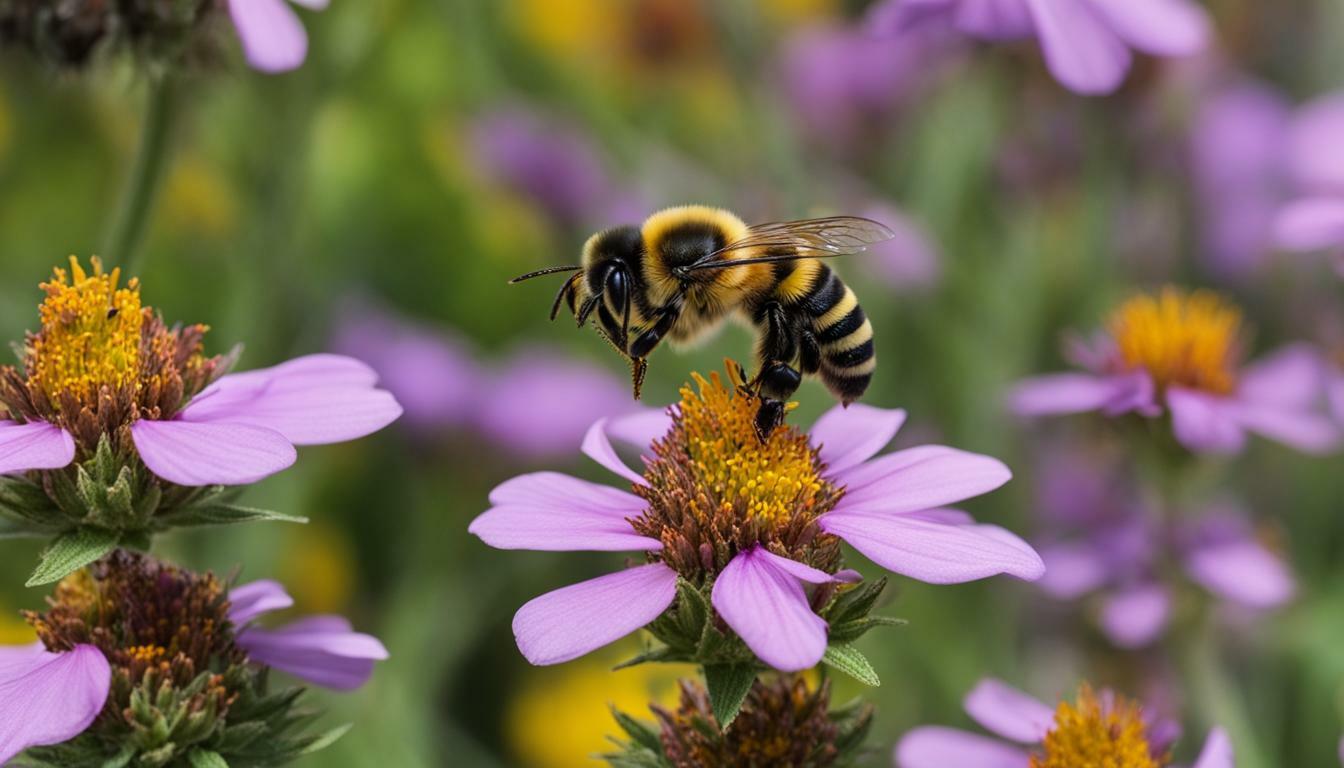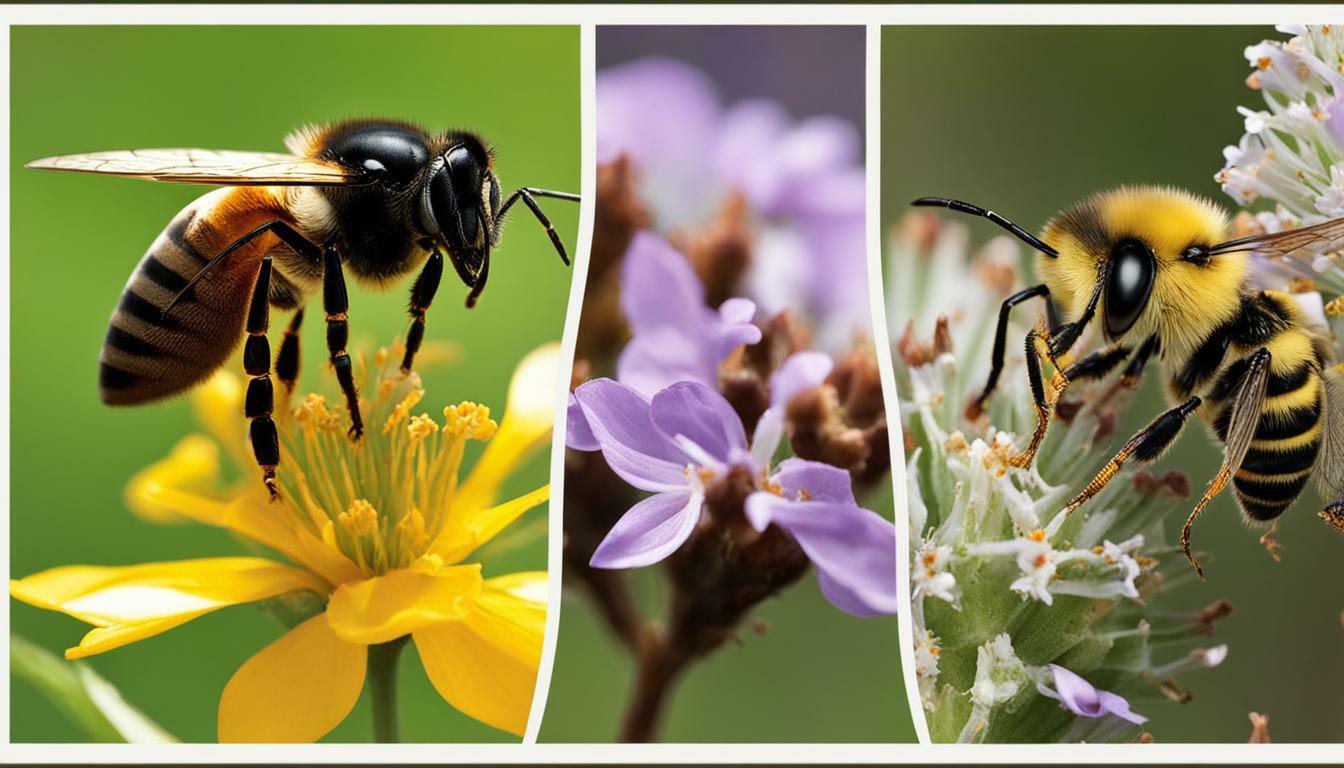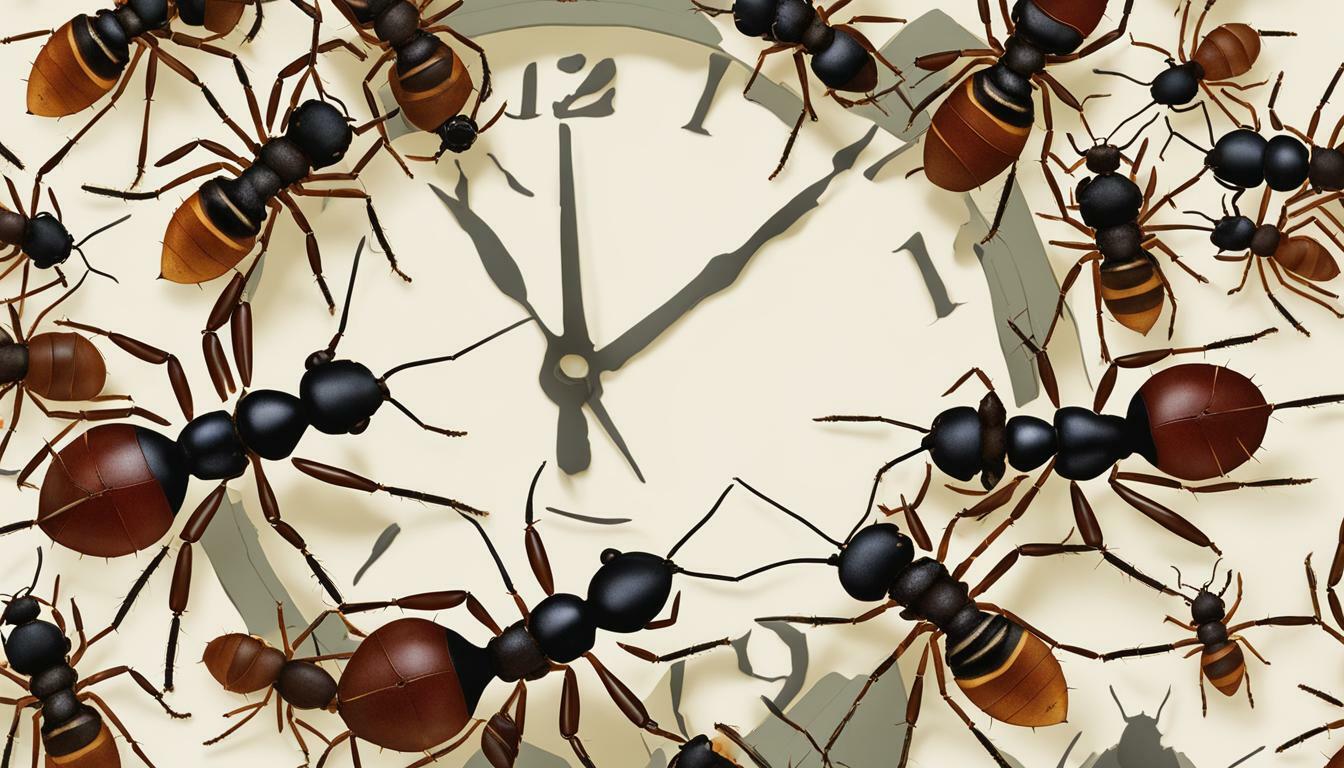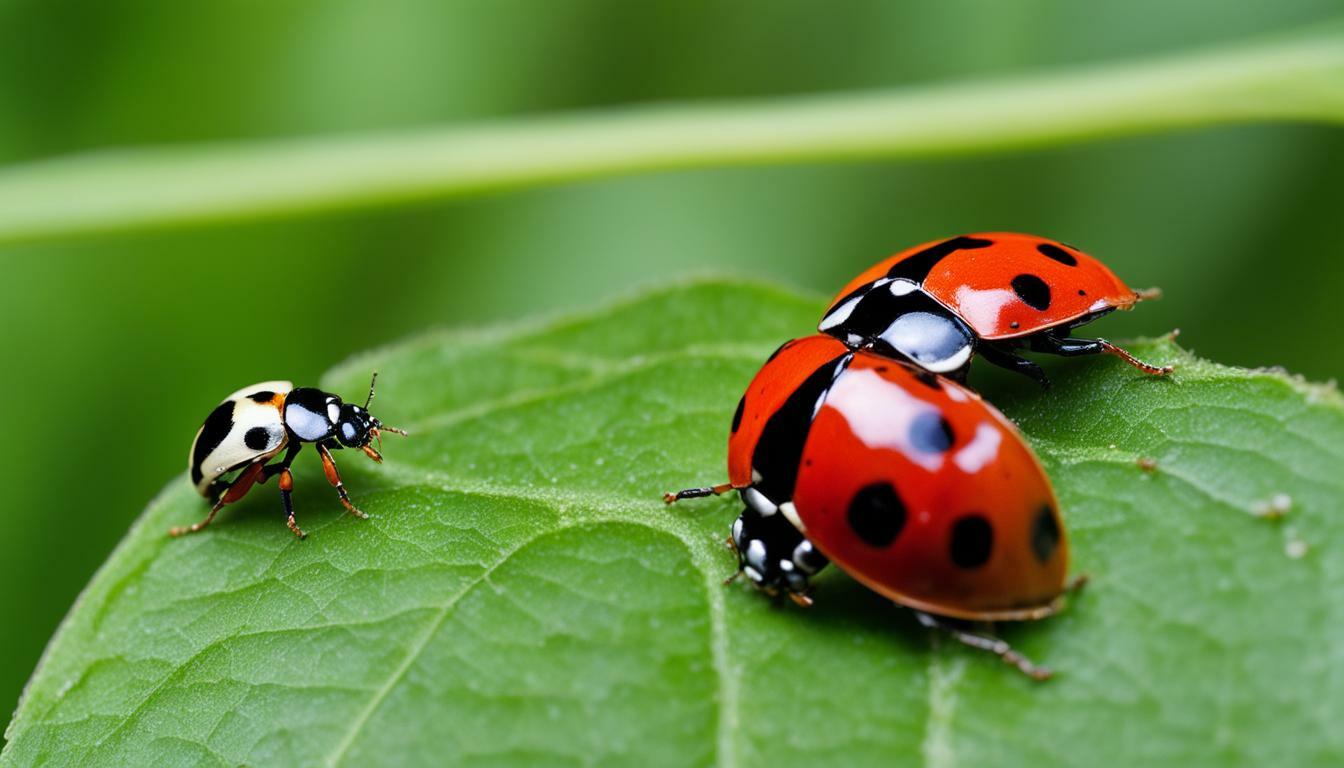As we go about our daily lives, we often come across bees buzzing around us. While most of us are familiar with honeybees and their role in producing honey, there are many other types of bees out there. Two of the most commonly encountered bees are bumblebees and carpenter bees. While they may look similar at first glance, they have distinct characteristics that set them apart.
It’s important to understand the difference between bumblebees and carpenter bees, as their behaviors and habitats can impact our daily lives. By learning how to identify each type of bee and understanding their unique characteristics, we can help support these important pollinators and maintain a healthy ecosystem.
Key Takeaways:
- Bumblebees and carpenter bees have distinct characteristics that set them apart.
- Understanding the difference between these two types of bees is crucial for managing and supporting their role in pollination.
- By recognizing their behaviors and habitats, we can help ensure the conservation of these important pollinators.
Bumblebees vs Carpenter Bees: Characteristics and Identification
While both bumblebees and carpenter bees are important pollinators, they have several distinct physical characteristics that set them apart.
Bumblebees are typically larger and hairier than their carpenter bee counterparts, with a rounder, more robust body shape. They are also typically black and yellow in color, although some species may have orange or red markings as well. In contrast, carpenter bees are generally smaller, with a darker, shinier, and less hairy appearance. They have a more elongated body shape and are often a solid black or metallic blue-green color.
Another key difference between bumblebees and carpenter bees is their behavior. Bumblebees are social creatures that live in nests together, while carpenter bees are solitary and live in individual burrows they carve out of wood. Bumblebees also feed primarily on flowers, while carpenter bees tend to prefer wood for feeding and nesting.
Overall, these unique characteristics can help you identify the differences between bumblebees and carpenter bees with ease.
Bumblebees vs Carpenter Bees: Behavior and Habits
Bumblebees and carpenter bees exhibit different behaviors and habits that distinguish them from one another. These differences can be useful when identifying these pollinators and understanding their ecological importance.
Behavioral Differences: Bumblebees are typically social bees that live in colonies with a hierarchy of queens, workers, and drones. They are known to be less aggressive than other types of bees and only sting when they feel threatened. Carpenter bees, on the other hand, are solitary bees that do not live in colonies, although they may nest in close proximity to one another. They are known to be more territorial and may become aggressive when disturbed or provoked.
Habit Differences: Bumblebees prefer to forage on a wide range of flowering plants, including clover, dandelion, and wildflowers, while carpenter bees primarily forage on plants with tubular or bell-shaped flowers, such as honeysuckle and trumpet vine. Bumblebees also build their nests in a variety of locations, including underground, in grassy areas, or in trees, while carpenter bees prefer to nest in wooden structures or trees.
Understanding these behavioral and habitat differences between bumblebees and carpenter bees can be important for managing and conserving these pollinators. Providing a variety of flowering plants and nesting structures can support both species and contribute to the overall health of local ecosystems.
Bumblebees vs Carpenter Bees: Preferred Habitats
Both bumblebees and carpenter bees have distinct habitat preferences that can help you identify their presence in specific areas. By understanding their preferred habitats, you can take appropriate action to ensure their conservation and support their important role in ecosystem balance.
| Bumblebees | Carpenter Bees |
|---|---|
| Bumblebees prefer to nest in the ground or close to the ground, often in abandoned rodent burrows or under logs or rocks. They also tend to forage in open fields, meadows, and gardens. | Carpenter bees prefer to nest in wood, such as in dead tree trunks, fence posts, and old barns. They also tend to forage in wooded areas and gardens. |
It’s important to note that while carpenter bees can cause damage to wooden structures, they play an important role in pollination and should not be exterminated without cause. Instead, consider providing alternative nesting options, such as untreated wooden blocks or bee boxes, to discourage nesting in unwanted areas.
Bumblebees vs Carpenter Bees: Nesting Habits
Understanding the nesting habits of bumblebees and carpenter bees is essential to their conservation and management. Both bees have distinct nesting habits that set them apart from each other.
| Bumblebees | Carpenter Bees |
|---|---|
| Nests are primarily underground, in abandoned rodent burrows, piles of grass clippings, or other soft soil areas. | Nests are typically found in wood, including hollow stems, tree trunks, and even human-made structures like houses and sheds. |
| The nesting site is surrounded by a wax-like secretion that the queen secretes, providing insulation and protection for the colony. | Nesting sites are often reused from year to year, with new tunnels and galleries added each season. |
| The colony is typically small, ranging from 50 to 400 bees, and the queen will often abandon the nest once the colony has matured. | The colony can be much larger, with up to 1,000 bees, and the queen will continue to use and expand the same nesting site for several years. |
It’s essential to identify the nesting habits of these bees to maintain their populations. When managing areas where bumblebees or carpenter bees are nesting, it’s important to take appropriate measures to ensure their safety and prevent any harm to the colony.
Bumblebees vs Carpenter Bees: Importance in Pollination
Bumblebees and carpenter bees play a critical role in pollination, ensuring the reproductive success of various plant species. Both bees collect nectar and pollen to feed themselves and their larvae, inadvertently transferring pollen from flower to flower as they forage.
Bumblebees are particularly effective at pollinating plants with deep flowers that honeybees or other pollinators cannot access. Their large size and strong wing muscles allow them to vibrate flowers at a specific frequency, releasing pollen that might otherwise remain trapped.
Carpenter bees, on the other hand, are excellent pollinators of low-growing shrubs and trees, as well as fruit and nut trees. They are solitary bees that typically return to the same plant or tree to collect pollen, increasing the chances of successful pollination.
Both bumblebees and carpenter bees are important pollinators in agricultural settings, contributing to the growth and yield of crops such as tomatoes, peppers, and blueberries. They also play a crucial role in maintaining the health and diversity of wild plant communities, ensuring the survival of numerous species.
Conclusion
In conclusion, it is essential to understand the difference between bumblebees and carpenter bees. By recognizing their unique characteristics, behaviors, habitats, and nesting habits, we can correctly identify and manage these important pollinators.
Both bumblebees and carpenter bees play a crucial role in pollination and maintaining ecosystem balance. Bumblebees are social bees that prefer nesting in the ground, while carpenter bees are solitary bees that nest in wood. They differ in physical characteristics, with bumblebees being larger, furry, and having more colorful markings.
Understanding the importance of these bees in pollination is crucial. Bumblebees are effective pollinators for plants that require buzz pollination, while carpenter bees are efficient pollinators for larger flowers.
Saving the Bees
Both bumblebees and carpenter bees are facing habitat loss and declining populations due to human activities such as urbanization, pesticide use, and climate change. It is vital to protect their habitats and provide food sources to ensure their survival. Planting native flowering plants and avoiding the use of pesticides can help conserve these important pollinators.
By working together to protect bumblebees and carpenter bees, we can ensure the health and diversity of our ecosystems. Let’s do our part to protect the bees and appreciate the crucial role they play in our environment.
FAQ
Q: What is the main difference between bumblebees and carpenter bees?
A: The main difference between bumblebees and carpenter bees is their nesting habits. Bumblebees typically nest underground or in abandoned rodent burrows, while carpenter bees create nests by burrowing into wood.
Q: How can I differentiate between bumblebees and carpenter bees based on their appearance?
A: Bumblebees are generally larger and fuzzier than carpenter bees. Additionally, bumblebees often have brightly colored markings, while carpenter bees typically have a shiny black or blue-black appearance.
Q: Do bumblebees and carpenter bees have different behaviors when it comes to foraging?
A: Yes, bumblebees are known to be more social and form colonies, while carpenter bees are solitary. Bumblebees will forage in groups and communicate with each other, while carpenter bees forage individually.
Q: What types of habitats do bumblebees and carpenter bees prefer?
A: Bumblebees are often found in grassy areas with abundant flowers, such as meadows and gardens. Carpenter bees, on the other hand, are commonly found in areas with wooden structures, such as fences, decks, and eaves.
Q: How can I tell if I have a bumblebee or carpenter bee nest on my property?
A: Bumblebee nests are typically located underground or in abandoned burrows, while carpenter bee nests are often found in wooden structures. Look for small holes in wood surfaces for carpenter bee nests.
Q: Are bumblebees and carpenter bees important for pollination?
A: Yes, both bumblebees and carpenter bees are important pollinators. They play a crucial role in the pollination of various plants, contributing to ecosystem balance and the production of fruits and seeds.
 Skip to main content
Skip to main content


